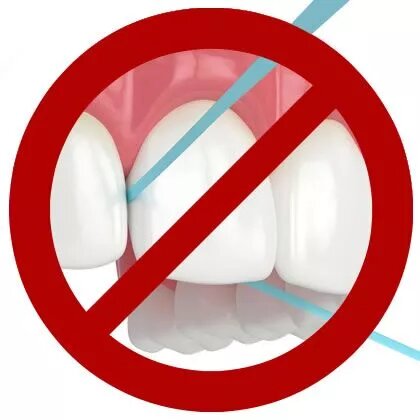Of all the things I talk to patients about to improve their oral health, year in and year out, flossing is the number one area I encounter the most resistance. I know you are tired of hearing that you need to floss. So, in the spirit of “if you can’t beat ‘em, join ‘em” here are 9 reasons why you should NOT floss.

1. Getting people to maintain social distance from you will be easier because eventually your breath will encourage them to.
Flossing will allow you to remove bacteria from hard to reach areas where bacterial plaque feeds on particles of food left between your teeth leaving a foul-smelling waste product behind. Dry mouth, pungent foods, smoking and certain medical conditions contribute to bad breath as well but flossing will help.
2. You will finally get a chance to find out how much tartar you can accumulate on your teeth.
Plaque allowed to remain on and between your teeth combines with minerals in your saliva and hardens to create calculus that attaches to your teeth like a barnacle. You cannot brush this calculus off of your teeth. You will be surprised at how much buildup will accumulate. Unfortunately, if you leave calculus on your teeth long enough bone loss will result.
3. You will get to see for yourself just how incredibly red and swollen gum tissue can get. You’ll be surprised to see how much they bleed without hurting.
The bacterial plaque that naturally forms inside your mouth causes your gums to become infected. They become red, swollen and inflamed. Blood blisters form in the pocket of gum tissue around your teeth and when these blisters are disturbed by brushing or flossing they break open and bleed sometimes quite a bit. The good news is once your teeth are cleaned, and you remove plaque and food particles by flossing and brushing, your gums can heal. The redness and puffiness will disappear and the bleeding will stop.
4. You will gain AT LEAST two minutes of prep time in the morning. You’ll get to bed sooner too.
The more you floss, the more proficient you will become and the less time it will take.
5. Think of the extra calories you will avoid by no longer being able to tolerate cold foods and drinks!
The acids created by bacterial plaque metabolism eats away at the fibers attaching your gum tissue to your teeth and to your jawbone. When attachment is lost, gum tissue slides away from the teeth and exposes the porous root surface. Tooth roots are not accustomed to cold and hot stimuli. When exposed to thermal stimuli pain signals are sent to your brain.
6. You will get to spend more quality time with your medical doctor and maybe meet a few more.
The chronic low-grade inflammation and bacteria from gum disease circulating in your bloodstream contribute to the severity of heart diseases, lung diseases, diabetes and a few other systemic diseases. For example, medical professionals have found that people with gum disease are two to three times more likely to have a heart attacks, stroke or other serious cardiovascular events. There may not be a direct connection but there is a growing suspicion that gum disease may be an independent risk factor for heart disease. For more information, check out this article from the Mayo Clinic.
7. You will save $3 – $5 per month by not buying floss, etc.! You will have saved enough money for the crowns and fillings you will need in no time.
No comment.

8. The research is weak supporting flossing as a means of preventing cavities and gum disease.
That’s true. There have been no randomized controlled studies in which participants were randomly assigned to either a daily flossing group or no flossing group, then followed over time to see whether those who flossed had lower rates of cavities and gum disease. Randomized controlled human studies of this type, designed to prove causality are often neither feasible nor ethical. So, while the research on flossing is weak, there is strong evidence that food particles attract bacteria that form plaque, which results in tooth decay and gum disease and that flossing removes food particles from places around your teeth that your toothbrush cannot reach.9. Your dentist and hygienist have no right to nag or lecture you.
You’re right, but it’s just too hard not to care. We really want you to be healthy.
Just in case you are not quite ready to put that floss away for good. Please read my next post on how to floss and use interdental cleaners properly.
Demonstrations are always helpful. Please check out the following video clips on cleaning between your teeth and under your gums with floss and string floss alternatives:
| How to use string floss (51 seconds): | Proper use of string floss alternatives: |
|---|---|
As always, please do not hesitate to contact me with questions or comments.
Yours in Health, Sharon Albright, D.D.S.
